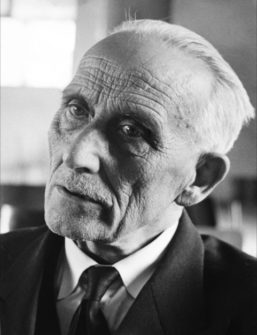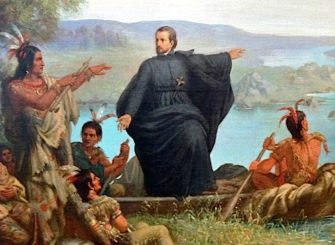
Brenna Moore’s wonderful book Kindred Spirits: Friendship and Resistance at the Edges of Modern Catholicism invites us to consider the ontology of Catholic friendships. While reading it, I found myself returning to one question: How do Catholic friendships exist amid the conditions of knowing, living, and relating that organize, and emanate from, modern nation-states? Here I’ll pose this question about the United States in a way that pays attention to the United States’ colonial underpinnings.
In Kindred Spirits, Moore recovers the spiritual friendship of Louis Massignon and Mary Kahil as it caught fire in 1934 on the day they rode by train together to a Franciscan chapel in Damietta, Egypt, and professed a shared vow to live their lives for Muslims (94). For the next three decades, Massignon and Kahil were radically altered by the porosity between them: their selves opening and mingling across distances, traversing boundaries of family, sexual mores, and the nation-state. This porosity collapsed, by extension, what Charles Taylor calls the “immanent frame,” that secular order that renders political and social life as bounded human affairs. Their friendship dissolved the modern conditions that permit a person to distinguish themself as an isolable actor, apart from God. “Massignon’s increasing belief that God was present in the intimacy of their bond had a way of letting this love [between he and Kahil] off its leash,” Moore writes, “as they experienced a madder and deeper passion” (96).
The friendship between Massignon and Kahil, and other early-to-mid twentieth-century spiritual friendships that Moore carefully narrates in Kindred Spirits, were, as the author suggests, glimmers of holy light tended among Catholic intellectuals, artists, and activists who recognized their specialness amid a gathering darkness. This specialness was marked by the accumulating clouds of fascism on one side, and the assumptions of godlessness orienting liberal and leftist political thought on the other. These “extraordinary friendships” conjured worlds apart from predominant strains of nationalism and liberalism and accompanying formations of race and empire, even as they sometimes fell short of their ideals and replicated those systems. These friendships also nurtured activism, “sustain[ing] a spiritual and sensual undercurrent out of which political action seemed to flow” (12).
In their brilliance, the “special friendships” Moore recounts in Kindred Spirits also cast light backward and reveal hidden dimensions of the secular modern they exceeded and defied. Though Moore’s own focus remains upon the “wide, wild, and weird field of desire” that sustained these friendships (18), her book provides us a vantage point for approaching, in ways that de-normalize and critique, secular friendships from the same period. The text invites us to attend to the rootedness of secular friendships in time and place, the epistemological and political conditions they’ve relied upon, and their effects in the world (including perhaps their inability to change it). Relatedly, Kindred Spirits invites us to look for other varieties of modern Catholic friendship, and to ask questions about their ontologies and their political effects.
In their brilliance, the “special friendships” Moore recounts in Kindred Spirits also cast light backward and reveal hidden dimensions of the secular modern they exceeded and defied.
To think about ontologies of friendship, Sylvia Wynter’s account of the coloniality of being is useful. Wynter identifies a “de-godding” process—specific to Europe during the age of its imperial expansion—which produced a new mode of being human. This human no longer bent toward the heavens to know who he was, Wynter tells us, but instead turned inward to realize his humanness through the exercise of Reason, the allegiance to the modern nation-state as the apotheosis of Reason, and the differentiation (dehumanization) of racial others. Though culturally specific, this transformed ontology of humanness came to be “overrepresented” as universal and as part and parcel of empire. Reading Moore alongside Wynter, we might now ask: What instances of Catholic friendship persisted (and persist) amid modern projects of empire? What forms of Catholic relationship have conformed to this ontological shift, i.e. to the genre of humanness that has sustained these empires? And which, if any, have exceeded it?
In my research and teaching, I tend to approach the United States as a political formation that is at once modern and settler colonial. I am interested in the US nation-state as an entity that has expended enormous energy, across the centuries, to manage selves, and relationships among them, in ways that ensure deference to its sovereignty, and buy-in to the liberalism that is the medium for its manifestation. I try always to keep in mind how all this has worked to dispossess Native peoples. As a historian of Catholicism, I am interested in Catholic modes of being—and, now reading Moore, in Catholic friendships—that happened in relation to this settler colonial matrix. Reading Kindred Spirits helps me to ask new questions about porosity in these relationships, and specifically about how porosity—if and when it persists amid the modern settler colony—positions Catholic friendships in relation to the sovereignty of the U.S. nation-state.
I will not draw final conclusions here, but I will share a two-part example for consideration. While there is always some risk in drawing sharp contrasts between “Protestant things” and “Catholic things,” here it might prove useful. During the late nineteenth century, a group of prominent US Protestants extended friendship as a mode of relating to Native peoples. As Moore notes in Kindred Spirits, “Catholics were [..] not the only ones drawing from the language and practice of friendship to engage the political world.” Though when their Protestant counterparts did it, they often (if not always) did so with more optimism about liberalism and modernity (14–15). True to this form, to be a “Friend of the Indians”—in the nineteenth century US Protestant sense—was to commit to a relationship that would achieve for Native peoples what their White “friends” already enjoyed: full inclusion in the US political project. The work of assimilation that Friends of the Indians supported was, of course, intended to achieve this purpose. During this period, Protestants involved in crafting US Indian policy also included the federal government as a party in these “friendly” relations. Native children “should be taught to look upon [..] the United States government as their friend,” explained US Commissioner of Indian Affairs Thomas Morgan in 1889 (223). The Friends of the Indians represent, I’d argue, a secular deployment of friendship: an imagined (if not actualized) relationship of care, extending between people who are themselves commonly oriented (again, in the imaginations of those friends) not toward God but toward the benevolent blessing of the liberal nation-state.

During the same period of US history, settler Catholics also imagined friendship in relation to Native peoples. Sometimes, though, those friendships encompassed supernatural forms. In 1876, Catholic journalist James McMaster used his newspaper to launch a “Confraternity for Reparation to the Indians.” In Catholic worlds, confraternities are groups of lay people joined in common work of charity, piety, or both. Within the Confraternity for Reparation, US Catholic devout would form “bands” comprised of fifteen individuals, with each band collectively producing fifteen daily Hail Mary prayers, as well as forty-five cents (three cents per member), “for the poor Indians and their friends.” The plight of Native peoples, McMaster wrote, “is one that ought to alarm us all.” “We Catholics [..] ought to lay these things to heart; for we are part of the American people, and when their punishment comes, we, assuredly, shall not escape our full share.”[1]
Within the Confraternity for Reparation, friendships extended not only between devout Catholics and Native people they prayed for but—just as importantly—between the Catholic living and the Catholic dead. The dead “can be made partakers of the benefits of this Confraternity, by having living friends contribute [on their behalf],” McMaster explained.[2] The inclusion of departed friends, and building of a work of charity with them, was compelling and real for living Catholics who participated. One eight-year-old from Pennsylvania promised to provide prayers and alms for “ten living and five deceased.” “We [..] promise, ‘honor bright, to say fifteen Hail Marys daily, from our little brother’s box, who died one month ago today,” wrote a pair of siblings from San Francisco.[3] In this way, family ties—and friendships too—were nurtured, and boundaries between life and death dissolved. This all happened as Catholics committed to the work of funding Indian missions, which saved souls in line with theology and doctrine, but also enacted the US colonial dynamic of dispossession.
The Friends of the Indians represent, I’d argue, a secular deployment of friendship: an imagined (if not actualized) relationship of care, extending between people who are themselves commonly oriented (again, in the imaginations of those friends) not toward God but toward the benevolent blessing of the liberal nation-state.
How can we reconcile the porosity that permeated confraternities—the Catholic sensibility of selves reliant upon one another in the work of salvation, and of relationships of love, manifest in collective acts of charity, that ignored boundaries between natural and supernatural—with the modern colonial system they sustained through their devotional work? Do episodes like this represent transitional moments in a history of US Catholicism that is a story of both secularization and settlement? Or are they evidence of a more complicated—and perhaps less evenly modern—US colonial reality? These are some of the important questions Kindred Spirits raises for me in its attention to spiritual friendships that not only survived but flourished in a modern and secular age.
[1] “The Prefecture Apostolate of Indian Country,” New York Freeman’s Journal and Catholic Register 37, no. 30 (October 10, 1876).
[2] “Union of Prayer and Alms,” New York Freeman’s Journal and Catholic Register 37, no. 32 (October 21, 1876).
[3] “Prayers and Alms in Reparation to the Poor Indians,” New York Freeman’s Journal and Catholic Register 37, no. 36 (November 11, 1876); untitled, New York Freeman’s Journal and Catholic Register 37, no. 38 (December 2, 1976).

